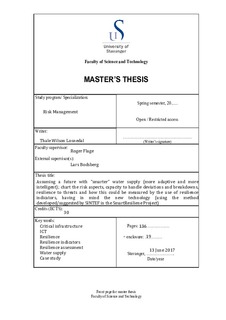| dc.description.abstract | Proper functioning of Critical Infrastructures (CIs) is crucial for the welfare of society. However, as for other natural and man-made systems, disruptive events and disasters occur from time to time. Major catastrophes can leave large-scale CI systems devastated, defenseless and non-functioning. Such breakdowns have proven rather rare, but as demonstrated after disasters like Hurricane Katrina in 2005 and the September 11 in 2001, the coping ability is lacking.
As a result of the incidents referred to above, there has been a significant emphasis on understanding the concept of resilience, and how this could be implemented in large-scale infrastructure systems. This thesis explores a new methodology developed by SINTEF that attempts to measure infrastructure resilience by the use of resilience indicators. This is a holistic framework that considers an integrated view on resilience assessment, addressing a broad variety of issues including human factors, sociology, security, economy, etc., and the increased vulnerability due to changing threats. This holistic approach considers both conventional indicators obtained from a top-down manner, and new indicators delivered out of big and open data sources, making it suitable to assess resilience of “smart” critical infrastructure as well. The framework consists of a series of steps/levels that include the identification of area, CIs, threats, phases, issues and indicators.
The ability of the proposed framework in assessing resilience is demonstrated by applying (parts of) the methodology to a case study representing one critical infrastructure - the water supply in the city of Stavanger. The case study identifies relevant threats towards the water supply through interviews and literature reviews. However, for simplicity, only two threats were considered when issues and corresponding indicators were identified. These threats were chosen on the basis of probability of occurrence and associated consequences. Thus, the methodology was applied to a high probability, low consequence kind of threat and a low probability, high consequence kind of threat, presented by water leakages and hacking attack respectively. | nb_NO |

